
SELF-HELP AND RESILIENCE IN THE DEMOCRATIC REPUBLIC OF CONGO
I interviewed Bertin Kalimbiro from the Democratic Republic of Congo about his work in the Goma region to grow food safely and help people threatened
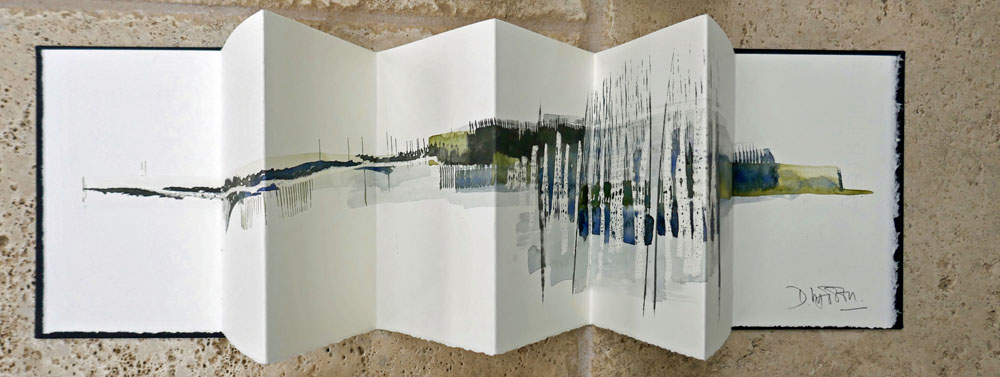
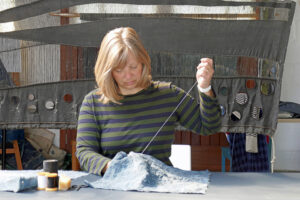
I interviewed mixed-media artist Debbie Lyddon who uses all her senses to create artworks informed by memory, close observation and the rhythms of nature. Other themes in Debbie‘s extraordinary work are remoteness, impermanence and the effects of sound, stillness and silence. As well as cloth, Debbie’s materials include salt, bitumen, wax and varnish – all drawn from her coastal surroundings at Wells-next-the-Sea, Norfolk.
Leslie: Can you give an overview, please, of the different types of art you create and your sources of inspiration?
Debbie: My work is a response to experiences of walking the coast where I live in North Norfolk. I create word-sketches, drawings, 2-D and 3-D textile works that explore natural phenomena and the continuous, and often infinitesimal, processes of change that transform the landscape and the objects in it.
Leslie: Can you describe, please, how walking, collecting, telling stories and the use of words have helped you make some of your most important artworks?
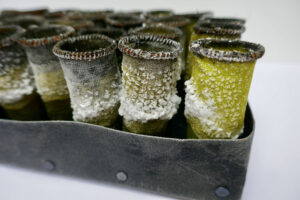
Debbie: I walk every day and as I walk, I notice things. I rarely have a sketchbook or a camera with me as I like to go out unencumbered, so if something catches my attention, I hold it in my memory until I can document it. My natural inclination is to write and when I get home, I will jot down a few words to capture the essence of a remembered experience. Memories are not like photographs that are an exact representation of what happened, instead as I recall them, I reconstruct the experience and my imagination helps out. I move words around to create a new a construction, or story, that is the essence of a remembered reality. These written down reconstructed memories form the basis for my work.
Leslie: What are the material processes you use to evoke the elements, particularly light, weather and water?
Debbie: I explore the effects the elements themselves have on cloth and how they can mark it. I like to use materials readily available to me and seawater is outside my studio door in abundance. I sew iron wire eyelets and other found, rusty objects into the work I make, and throw them into the sea so that the iron will rust and mark the cloth – rusting is a process that is happening continuously in the environment around me.
I am also very conscious of how light plays across my work and often make holes so that shadows are produced. Pulling out the weft threads is one technique I use to do this.
Leslie: Can you give a seminal example please, from your art of how “Cloth and traditional utilitarian hand-stitching are at the foundation of my work.” How do salt, bitumen, wax, varnish help to relate your cloth artworks to their surroundings?
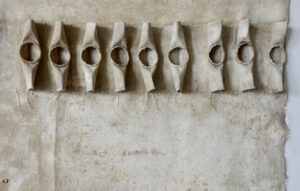
Debbie: I use stitch mainly to construct and not as decoration. I look at how cloth is used here on the coast and take inspiration from utilitarian tarpaulins, boat covers and sails, and I allude to their functional use in much of my work. The form of the Ground Cloths is inspired by boat sails and I have incorporated sewn wire eyelets, reefing points and simple seams that are to be found on both traditional and modern sails.
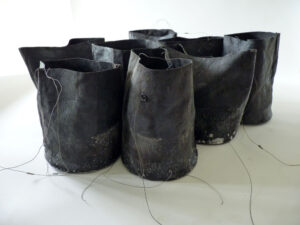
Tarpaulins and boat covers are protective cloths and in order to do their job properly they, in turn, need to be protected. The materials with which I coat the cloth – wax, linseed oil, bitumen and paint – are substances that have been traditionally used to preserve and protect sails, ropes and nets. As a child I remember seeing and smelling bitumen coated lobster pots and ropes – the smell takes me right back to that time and place. Bitumen Buckets were an experiment in whether I could make a waterproof and watertight container. Although they are now empty there is still a residue of salt remaining on the bitumen coated canvas and a tarry smell pervading the air.
Leslie: Why does impermanence, change and degeneration play a large part in the making of your work?
Debbie: Nothing is ever the same here on the coast. As I walk the same paths week after week, outwardly they appear to be the same, but I see small changes each time I walk them. The wind blows the sand into ever-changing mounds and hollows, the tide goes in and out, the wildlife comes and goes depending on the time of year, and plants spring up and die down. Each has its own pulse of diurnal, monthly or yearly patterns. I am always looking for that unique, and often fleeting, constellation of natural happenings. These are what really inspire me.
The use of salt is intrinsic to my exploration of impermanence, change and degeneration in the environment. It is an ephemeral medium that has the potential to change with the humidity of the atmosphere. The salt crystals can completely disappear in a damp environment and then appear again, often in a different form, when it becomes dryer. Salt is a corrosive material, and I expect the work to degenerate very slowly over time.

Leslie: How does the N. Norfolk coastline affect your art? What are its visual, aural and tactile aspects, and how do you try to convey them?
Debbie: The perception of the environment using all the senses is at the heart of my work. I am particularly interested in the aural sense. As a former musician I am very used to seeing sound written down in the form of music notation, and as an artist I try to capture the essence of a sound visually. Graphic notation is a way of writing down sound through drawing and my mark-making includes bursts of bird song, the continuous hum of distant waves or the rhythmic smack as the wind rattles halliards against masts. It’s all about rhythm, space and the passing of time as I make a connection between what I see and what I hear.
Leslie: Why and in what way does climate change and flooding figure in your life and art?
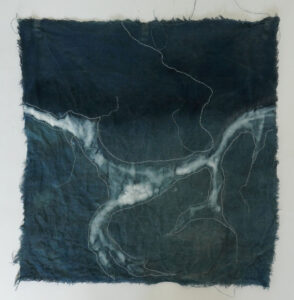
Debbie: The East coast is flat and in December 2013 was inundated by a tidal surge. My studio had 1m of water in it and other homes and businesses were also overwhelmed by the sea. It is an issue that people living on this part of the coast are going to have to deal with again in the future. In the past dykes have been built to hold back the sea and in Wells there is a flood barrier that protects part of the town when there is a very high tide or surge. However, hard defences only deflect the passage of the sea to other places and there is a belief that a more natural method of controlling a tidal surge by distributing the flood water more widely over salt marsh and flood plain that could be less invasive. It is a highly pertinent issue that with climate change is only going to get worse. It is necessary that I reflect on the consequence of the convergence of wind, tide and weather.
Leslie: Can you describe how the idea of ‘Holding Place’ features in your art, please?
Debbie: I like the play on words in the title Holding Place.
I make a lot of containers. Some of them are practical and are a simple vessel for putting found objects – a holding place for holding something.
Other vessels are more complex and are subjected to processes that can be found in the environment: seawater rusting metal, salt-water evaporating to form crystals, or found pigments to colour cloth – a vessel that has been subjected to a process that holds (a sense of) place.
Next week, to find out about ethical, sustainable, transparent banking I interview Neil Sellers, Head of Credit Risk at Triodos Bank UK.
ABOUT LESLIE TATE’S BOOKS:

I interviewed Bertin Kalimbiro from the Democratic Republic of Congo about his work in the Goma region to grow food safely and help people threatened

I interviewed computer expert and sustainability campaigner Dr Erlijn van Genuchten, who writes easy-to-understand books based on science full of practical suggestions for planet-friendly living.
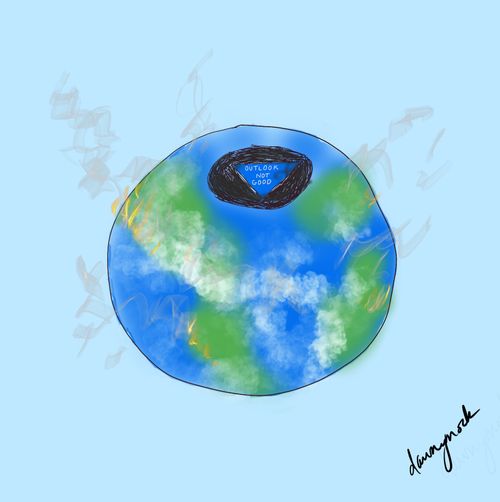
I interviewed Canadian cartoonist Dawn Mockler about how she works on cartoons that might be environmental or wordless but always witty – especially her famous
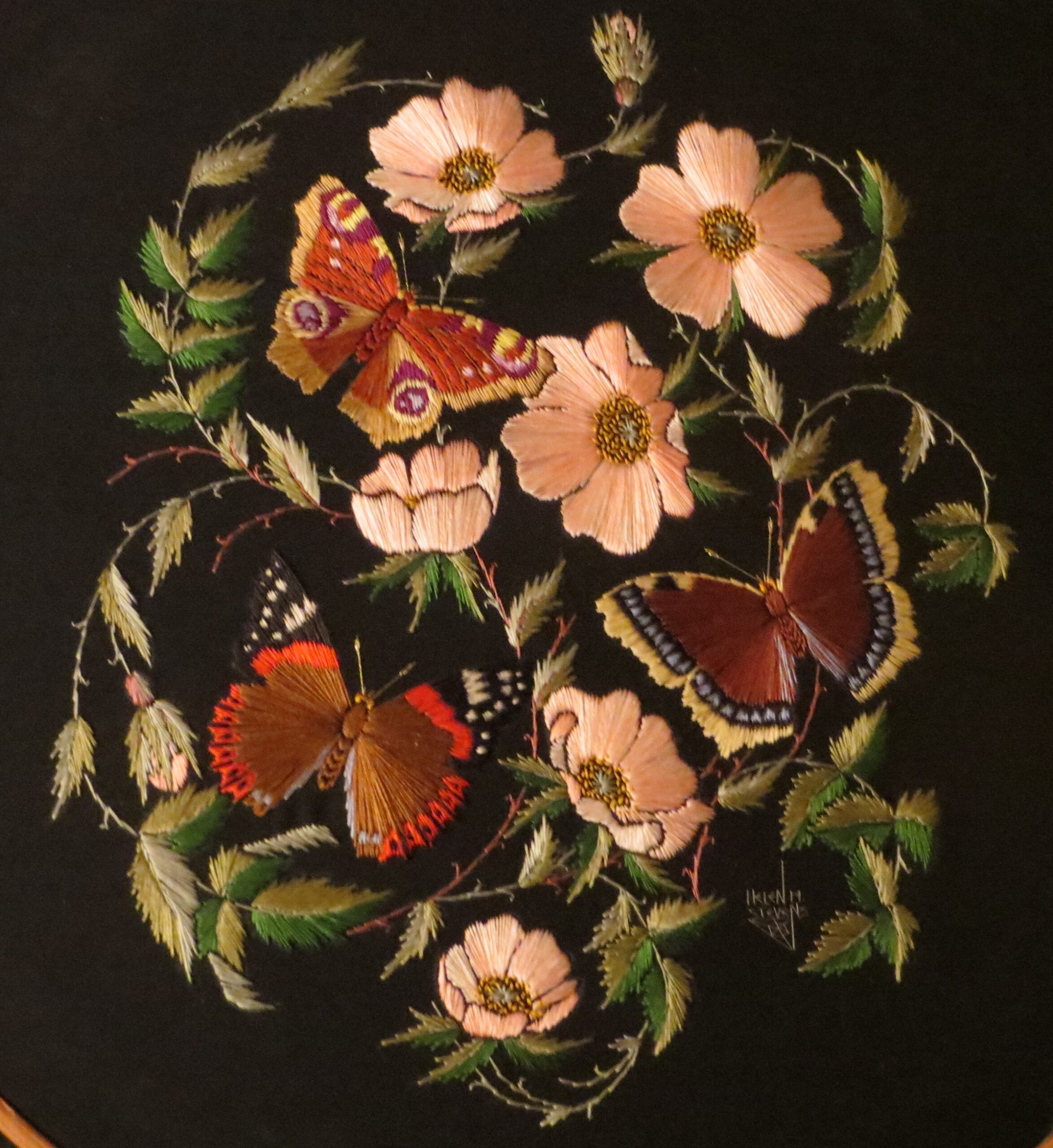
I inteviewed Helen M Stevens about how she has revived the art of embroidery, creating original contemporary patterns while studying and drawing on, “One of

I interviewed Councillor Rachel Smith-Lyte about the origins of her passion for nature and her environmental activism. Rachel tells the story of her teaching (and
| Cookie | Duration | Description |
|---|---|---|
| cookielawinfo-checkbox-analytics | 11 months | This cookie is set by GDPR Cookie Consent plugin. The cookie is used to store the user consent for the cookies in the category "Analytics". |
| cookielawinfo-checkbox-functional | 11 months | The cookie is set by GDPR cookie consent to record the user consent for the cookies in the category "Functional". |
| cookielawinfo-checkbox-necessary | 11 months | This cookie is set by GDPR Cookie Consent plugin. The cookies is used to store the user consent for the cookies in the category "Necessary". |
| cookielawinfo-checkbox-others | 11 months | This cookie is set by GDPR Cookie Consent plugin. The cookie is used to store the user consent for the cookies in the category "Other. |
| cookielawinfo-checkbox-performance | 11 months | This cookie is set by GDPR Cookie Consent plugin. The cookie is used to store the user consent for the cookies in the category "Performance". |
| viewed_cookie_policy | 11 months | The cookie is set by the GDPR Cookie Consent plugin and is used to store whether or not user has consented to the use of cookies. It does not store any personal data. |